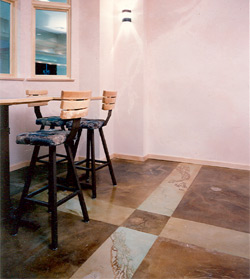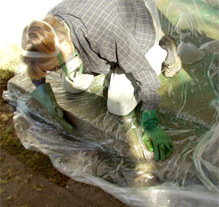|
April 30, 2004
In This Issue of The Acid Staining Newsletter
Acid-Staining Outdoors
We have been receiving a number of inquiries about the pros and cons of acid-staining concrete surfaces which are outdoors. When we first entered this business, we were happy to accept any large job and did many square feet of patios, portals and pool surrounds. We soon learned some major drawbacks to staining outdoors, and now turn away many of these jobs.
We found that the acid stain is not a problem, but the sealers can be. In the high desert of New Mexico, which has strong ultraviolet light radiation from the sun, both water-based acrylic sealers AND the more expensive solvent-based acrylics can start to blister and flake, just like your skin when it gets mildly sunburned. This can occur at altitudes of 5,000 feet (the level of Albuquerque) after a few months, and at altitudes of 7,000 feet (up in Santa Fe) just a few WEEKS after application. In fact, our xylene-based sealer began to blister sooner than the water-based and was harder to repair.
The sealers are necessary to protect the stain, since rain can "reactivate" the stain and make it wash away, flowing downhill and streaking. I have had clients suggest that we eliminate sealer altogether, but I would not want to guarantee that the concrete stain would not fade or wash off after a while. One of my seminar students said he omitted sealer on an outdoor job and that it still looks good two years later. It could be that in mild climates and on non-sloping slabs this might be a solution.
In our locale, doorways and porches get snowy or icy in the winter. Our sealer added enough slickness that slipping became a real hazard. One homeowner told me he tried to shovel the freezing snow off as fast as possible and found that his shovel scratched through our sealer to the stain. Stain manufacturers all warn that outdoor slabs should be broom-finished or otherwise troweled for slip-resistance. This helps, but the top ridges of the broom finish then carry all the foot traffic and can be scraped gray by abrasion, while the low places, where stain and sealer are not walked on, look even darker by comparison.
|
|
As a result of all these factors, we only accept those outdoor stain jobs which are covered by roofing or shade, and if the concrete has a smooth finish, I warn the client in writing about the "slippery when wet" problem, and give detailed instructions for sealer maintenance, as well.
Swimming pool surrounds present the same problem of slip hazard, with the additional problem that the strong acid, used to balance the pH of pool water, can penetrate your sealer and bleach out the stain color in spots or rings. In fact, when we accidentally spill some stain color on a gray driveway during our work, we remove it later by acid-etching through it with a ten-to-one solution of water and muriatic acid. This is much less strong than the undiluted acid which is likely to run down the side of the pool-tender's bottle when he sets it down on your stained pool border.
The sealers for acid stains are designed to "breathe" so that water can rise out of the new concrete slab for a few years without creating efflorescence over your stain color. However, that permeability is a two-way street. While acid can bleach your stain right through the sealer, spilled olive oil or fat from the barbeque can just as easily create a darker spot under the sealer, as it penetrates the stained slab and makes it appear permanently wet.
We do not encounter the oil-spotting problem indoors in kitchens because the two or three coats of wax applied over the sealer seem to protect the floor from this effect. (It may happen eventually, if a client ignores your instructions to wax the floor when it begins to look dull and ends up living on a scratched and thinning coat of sealer).
|
|
As you may know, the acid stain process is basically the same whether your slab is outside or inside, except that wax is omitted, since it cannot withstand extreme swings in temperature. Another problem you will encounter with staining outdoors is in masking the walls of the house which adjoin your stain area. Stucco can only be masked with colored duct tape, so masking becomes more expensive and laborious. Gray duct tape has too much tackiness, and regular masking tape does not give enough.
|
You may also need to clear away dirt and mulch piled up against the outdoor slab, and stain all the edges, so as to give the impression that the stain color runs completely through the slab. This takes more effort, but gives the slab a nice solid look.
The photos show my crew staining the walled and shaded front porch of a small bungalow with Scofield's Weathered Bronze, and laying plastic into it for visual texture. The dirt around the outer step was cleared away with a shovel prior to cleaning and stain.
I do not believe that acid staining is appropriate for new driveways and sidewalks. There are some wonderful integrally-colored concrete techniques available which add to surface durability and can give the look of cobblestone, wood or brick. I feel that these are the tricks to use outdoors and prefer to save my thunder for interior floors. That way we never have to stop working on rainy days.
|
|
|



